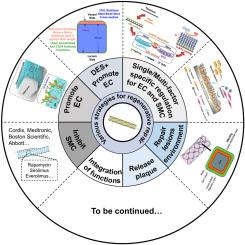心血管支架表面功能化的最新进展
IF 18
1区 医学
Q1 ENGINEERING, BIOMEDICAL
引用次数: 0
摘要
心血管疾病(CVD)是威胁人类健康的全球头号杀手。血管支架的临床应用提高了心血管疾病患者的生存率和生活质量。然而,尽管支架为患者带来了诸多益处,但仍存在明显的并发症,如血栓形成和支架内再狭窄(ISR)。表面改性技术是提高血管支架临床疗效和减少并发症的有效策略。本文回顾了基于表面功能涂层技术的血管支架开发策略,旨在解决临床应用中的局限性,包括抑制内膜增生、促进再内皮化等。这些策略改善了内皮修复,抑制了血管重塑,从而促进了支架植入后的血管愈合。然而,靶血管的病理微环境和脂质斑块是动脉粥样硬化(AS)发生和经皮冠状动脉介入治疗(PCI)后血管修复受损的关键病理因素。因此,恢复正常生理环境和清除斑块也是 PCI 后促进血管修复的治疗重点。遗憾的是,这方面的研究还很有限。本文回顾了近十年来基于表面工程技术的血管支架的研究进展,为支架的开发提供指导。本文章由计算机程序翻译,如有差异,请以英文原文为准。

Recent advances in surface functionalization of cardiovascular stents
Cardiovascular diseases (CVD) are the leading global threat to human health. The clinical application of vascular stents improved the survival rates and quality of life for patients with cardiovascular diseases. However, despite the benefits stents bring to patients, there are still notable complications such as thrombosis and in-stent restenosis (ISR). Surface modification techniques represent an effective strategy to enhance the clinical efficacy of vascular stents and reduce complications. This paper reviews the development strategies of vascular stents based on surface functional coating technologies aimed at addressing the limitations in clinical application, including the inhibition of intimal hyperplasia, promotion of re-endothelialization. These strategies have improved endothelial repair and inhibited vascular remodeling, thereby promoting vascular healing post-stent implantation. However, the pathological microenvironment of target vessels and the lipid plaques are key pathological factors in the development of atherosclerosis (AS) and impaired vascular repair after percutaneous coronary intervention (PCI). Therefore, restoring normal physiological environment and removing the plaques are also treatment focuses after PCI for promoting vascular repair. Unfortunately, research in this area is limited. This paper reviews the advancements in vascular stents based on surface engineering technologies over the past decade, providing guidance for the development of stents.
求助全文
通过发布文献求助,成功后即可免费获取论文全文。
去求助
来源期刊

Bioactive Materials
Biochemistry, Genetics and Molecular Biology-Biotechnology
CiteScore
28.00
自引率
6.30%
发文量
436
审稿时长
20 days
期刊介绍:
Bioactive Materials is a peer-reviewed research publication that focuses on advancements in bioactive materials. The journal accepts research papers, reviews, and rapid communications in the field of next-generation biomaterials that interact with cells, tissues, and organs in various living organisms.
The primary goal of Bioactive Materials is to promote the science and engineering of biomaterials that exhibit adaptiveness to the biological environment. These materials are specifically designed to stimulate or direct appropriate cell and tissue responses or regulate interactions with microorganisms.
The journal covers a wide range of bioactive materials, including those that are engineered or designed in terms of their physical form (e.g. particulate, fiber), topology (e.g. porosity, surface roughness), or dimensions (ranging from macro to nano-scales). Contributions are sought from the following categories of bioactive materials:
Bioactive metals and alloys
Bioactive inorganics: ceramics, glasses, and carbon-based materials
Bioactive polymers and gels
Bioactive materials derived from natural sources
Bioactive composites
These materials find applications in human and veterinary medicine, such as implants, tissue engineering scaffolds, cell/drug/gene carriers, as well as imaging and sensing devices.
 求助内容:
求助内容: 应助结果提醒方式:
应助结果提醒方式:


